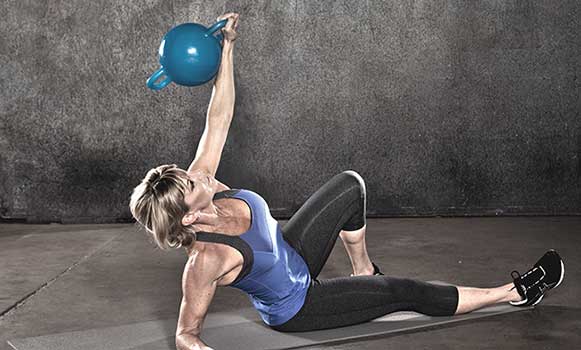
When it comes to introducing new products, the fitness industry appears to be a limitless supply of creativity and ingenuity, applying new materials and elements to create functional and highly effective workouts. From iron to sand to water, a wide range of products are now available, each utilizing these elements in unique ways. One of the latest offerings is the Kamagon Ball®, which is a hybrid of a medicine ball and a kettlebell, but with two handles, a forgiving plastic surface and a dynamic shifting load of water inside the ball.
Kamagon Ball Workout Considerations
- Space: Minimum space is a participant’s height squared.
- Warm-up and Acclimation: Perform a specific acclimation and warm-up prior to the main body of the workout.
- Breathing: Breathe continuously. During explosive movements, exhale on the concentric phase of the exercise.
- Progression: Progress resistance and skills slowly and safely. Allow each individual to progress at his or her own pace, regardless of others’ progress.
- Water Resistance: The amount of water in the Kamagon Ball can be adjusted to increase or reduce the amount of load and intensity of the exercises
- Footwear: Athletic shoes that favor lateral stability are recommended.
- Supervision: Beginners need to be well supervised, and children should not use the Kamagon Ball as a toy.
- Durability: The Kamagon Ball is not designed to be slammed against the floor or a wall as this may damage the product.
- Handles: The Kamagon Ball handles are designed to hold and move the ball around the body. Do not use the handles of the Kamagon Ball for planking as they are not designed for weight-bearing exercises.
- Sweat: Keep a towel close by to wipe sweat off your hands and the handles when using the Kamagon Ball so that you don’t lose your grip on the handles.
- Jewelry: Remove watches and all wrist jewelry before working out with the Kamagon Ball.
- Ball Plug: Make sure that the plug of the Kamagon Ball is firmly tightened before each use.
The Kamagon Ball was designed to facilitate total-body, integrated movement that effectively and efficiently recruits the core musculature, explains Mark Reed, vice president of Kamagon Fitness. Because it is filled with water, the Kamagon Ball is a destabilized weight, which means it is the ball itself is the point of instability (as opposed to performing strength or balance exercises on an unstable surface, for example). In fact, compared to an equal amount of static weight, the water movement within the ball and the weight/mass of the ball requires greater recruitment of the muscle fibers when performing the same number of repetitions. So, rather than having clients stand on an unstable surface and manipulate a stable object with their hands, training with the Kamagon Ball involves having clients stand on a stable surface and manipulate an unstable object. The very nature of this type of instability has a great potential for carryover into activities of daily living and sports performance.
The ball can be held like a medicine ball, or with two hands on one handle (like a kettlebell), one hand on each handle or even one hand on the ball. This allows for creativity in the exercise selection. The water motions can vary from powerful to subtle, depending on the exercise and the needs of the user. Here are some of the features that make the Kamagon unique:
Hydro-Inertia
Hydro-Inertia® is the utilization of water within the Kamagon Ball to create an unstable resistance and moving mass within a mass, which in turn enhances core musculature recruitment. Hydro-Inertia can be maximized with powerful, explosive movement sequences, plyometric exercise, or even slow, controlled, balance-oriented movements that require refined motor skills.
Dual U-shaped Handles
During both sports and activities of daily living, the objects being manipulated typically have a center of mass outside the hand (e.g., golf club, grocery bags). Dumbbells held in the palm of the hand keep the center of mass of the dumbbell closer to the hand, relatively proximal to the joint. By contrast, the Kamagon Ball’s two U-shaped handles create a center of mass that is away from the hand, thus providing a unique and functional challenge to the nervous system.
Center of Gravity Displacement
Center of gravity (COG) is the balance point of an object, a body or a unified system (a person lifting a Kamagon Ball, for example). COG is the point of an object where all forces add up to 0. The COG for a standing adult human is the midpelvic cavity, between the symphysis pubis and the umbilicus.
When COG is in motion, such as when lifting the Kamagon Ball, the COG of the ball is dynamic—it changes through the motion due to the Hydro-Inertia. Therefore, the exerciser’s COG must change with it. Most Kamagon Ball exercises are loaded on one side only, and this asymmetrical dynamic load shifts the COG and creates a greater degree of instability, requiring an increased amount of core stabilization and balance.
Complex Leverage System
Leverage is the application of force through rigid objects (levers). A system of levers has a tendency to produce rotational force or torque. The human body is a system of levers (bones) and joints (fulcrums) and soft tissue attachments that enable us to manipulate our environment to achieve goal acquisition.
The human body is comprised of predominantly third-class levers, putting us at a biomechanical disadvantage (Figure 1). Humans have a shorter force arm than resistance arm because the tendons insert closer to the joint and the load we manipulate is concentrated farther from the joint. Therefore, the human body favors speed, dexterity and mobility at the expense of force output capacity.
Because many of the Kamagon Ball exercises are performed with momentum and speed (suitable for a third-class lever system), this results in improved exercise efficiency in sports and life performance. The nervous system is the direct link by which muscles are recruited for the desired action, and because the Kamagon Ball trains integrated movement (as opposed to an isolated individual muscle group), improvements in function are possible.
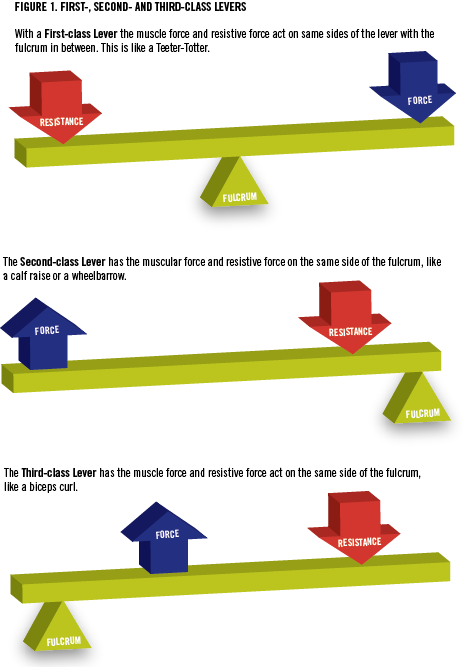
The Kamagon Ball Workout
This 15-minute circuit-training workout features five Kamagon Ball exercises. After performing a 3- to 5-minute warm-up, do each of the following exercises for 60 seconds with 10 seconds of recovery in between. Complete all the exercises in quick succession and then take two to three minutes to recover before performing a second set. If the exercise is unilateral, perform one side on the first set and the other side on the second. Finish the workout with some total-body stretches.

1. Power Clean
Set-up
- Standing with feet parallel and shoulder-distance apart, flex the knees into a half squat.
- Hold the Kamagon Ball in one hand, with the arm extended low between the legs.
Action
- Explosively drive the hips into extension while simultaneously pulling the ball directly up.
- Spiral the ball around the arm and catch it in a rack position.
- Spiral the ball back around the arm while bending the knees to return to the starting position.
Progression
- Increase the range of motion by flexing lower into the squat.
- Increase the speed of motion.
- Increase the amount of water in the ball.
Regression
- Decrease the range of motion by staying higher in the squat.
- Decrease the speed of motion (keep in mind, however, that this exercise should still be performed reasonably fast).
- Decrease the amount of water in the ball.
Safety Tips
- Brace the abdominals and maintain neutral spine throughout the movement
- Ovoid hyperextending the neck when at the bottom of the movement by keeping the gaze directly forward.
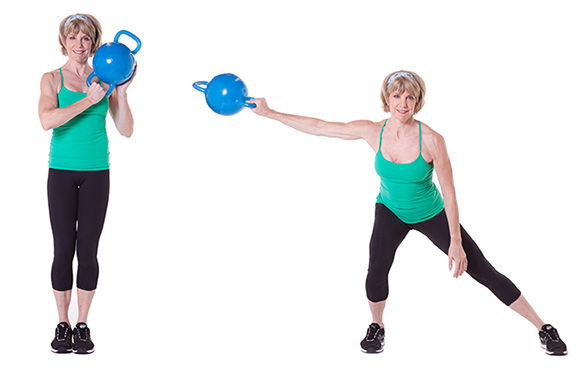
2. Lateral Swing and Lateral Lunge
Set-up
- Stand upright with feet together.
- Hold both handles of the Kamagon Ball in front of the chest
Action
- Lunge to the side with the right leg, taking a large step and keeping the feet parallel.
- Flex the right knee and hip and drive the hips back behind the foot.
- Simultaneously swing the ball laterally to shoulder height.
Progression
- Increase the range of motion by taking a larger step to the side and flexing deeper into the lunge.
- Increase the complexity by alternating right and left with a circular motion in front of the chest while moving from one side to the other.
- Increase the speed of motion.
- Increase the amount of water in the ball.
Regression
- Decrease the range of motion by taking a smaller step to the side and staying higher in the lunge.
- Decrease the complexity by performing all repetitions on one side before changing sides.
- Decrease the speed of motion.
- Reduce the amount of water in the ball.
Safety Tips
- Keep the feet parallel in the lunge.
- Maintain abdominal bracing while lunging and prevent lumbar flexion.
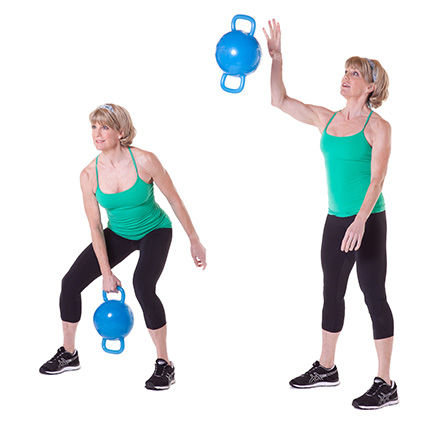
3. Squat Swing and Release
Set-up
- Stand upright with feet parallel and shoulder-distance apart, and the knees soft.
- Hold the Kamagon Ball in front of the body with both hands on one handle.
Action
- Flex the knees and lower into a squat, while simultaneously swinging the ball between the legs.
- Drive powerfully to an upright position, extending the hips and knees, while simultaneously swinging the ball upward and forward in a circular motion.
- When the hips and knees are fully extended and the ball is level with the head, release the ball, flipping it to catch it with the other handle.
- Flex the hips and knees and squat, allowing the ball to swing back down between the legs.
Progression
- Increase the range of motion by squatting lower and swinging higher.
- Increase the speed of motion.
- Increase the amount of water in the ball.
Regression
- Decrease the range of motion by staying higher in the squat.
- Keep holding the ball at the top of the movement—don’t release and catch it.
- Decrease the speed of motion.
- Decrease the amount of water in the ball.
Safety Tips
- Maintain braced abdominals, particularly at the bottom of the squat, and keep the lumbar spine in neutral posture.
- Focus on keeping the thoracic and cervical spine neutral throughout the exercise.

4. Diagonal Chop and Ribbon
Set-up
- Stand with feet parallel and shoulder-distance apart, with the knees slightly flexed.
- Hold the Kamagon Ball by both handles, rotating the ball to the outside of the right thigh, with the hips and feet rotating in the same direction.
Action
- Swing the ball in a circular motion around the left ear, then around the back of the head and around to the left hip.
- When the ball is behind the head, the hips should be extended and square to the front, with the feet parallel and knees soft.
Progression
- Increase the range of motion by deepening the lowered position.
- Increase the speed of motion and swing the ball powerfully around the head.
- Increase the amount of water in the ball.
Regression
- Decrease the range of motion by keeping the ball in front of the chest instead of behind the head.
- Decrease the speed of motion by eliminating momentum.
- Decrease the amount of water in the ball.
Safety Tips
- In the lowered position, rotate the hips and knees while pivoting the foot and lifting the heel.
- When the ball is behind the back of the head, fully brace the core to prevent lumbar hyperextension.
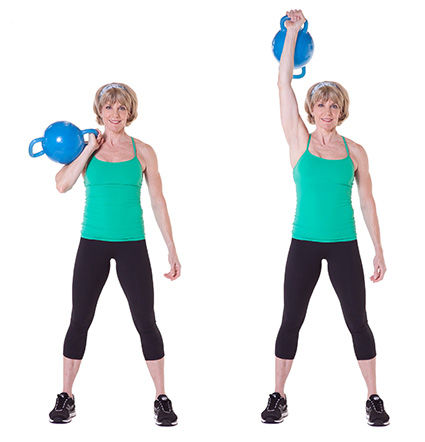
5. Unilateral Push Press
Set-up
- Standing with feet parallel and shoulder-distance apart, flex the knees into a half squat.
- Hold the Kamagon Ball in the “rack” position on one side.
Action
- Drive the hips up while simultaneously pushing the ball overhead, fully extending the elbow.
- Focus on pushing from the ground up, connecting the legs to the arm drive.
- Return to starting position.
Progression
- Increase the range of motion by performing a deeper squat.
- Increase the speed of motion.
- Increase the amount of water in the ball
Regression
- Decrease the range of motion by staying higher in the squat.
- Decrease the speed of motion (keep in mind, however, that this exercise should still be performed reasonably fast).
- Decrease the amount of water in the ball.
Safety Tips
- Brace the abdominals and maintain a neutral lumbar spine when the ball is overhead.





 by
by 








